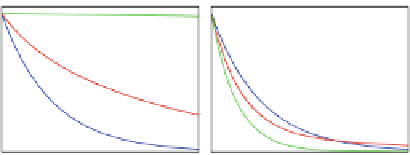Biomedical Engineering Reference
In-Depth Information
Fig. 9.12
The exciton
occupation for sub- (
a
)and
superradiant initial state (
b
)
for a DQD with
technologically achievable
energy mismatch
a
b
1
V =
0.1 meV
1 meV
10 meV
V =
0.1 meV
1 meV
10 meV
0.8
0.6
1meV,
for few values of the coupling
between the dots [
61
]
Δ
=
0.4
0.2
0
0
1
2
3
4
0
1
2
3
4
t
[ns]
t
[ns]
rate
, as expected for dots interacting with photon modes of different energy. For
increasing coupling between the dots, the evolution of the excitation becomes non-
exponential until the opposite limiting case
V
Γ
Δ
is reached, where the state
|−
becomes stable and state
decays with a twice larger rate.
The evolution of a superradiant state, which is particularly relevant for optical
experiments, is discussed in more detail in [
61
].
|
+
9.4.2
Vacuum-Induced Coherence
A consequence of the existence of sub- and superradiant states is a vacuum-
induced coherence effect which is related to spontaneous excitation transfer between
emitters and leads to population trapping in a decoherence resistant state [
121
]. The
initial state of the analyzed system is a localized single-exciton state,
,
which cannot be excited optically, but can appear naturally, e.g., as an effect of
incoherent trapping or controlled tunnel injection of carriers in an injection structure
similar to that studied in [
122
], but with two QDs instead of one. The localized initial
states may be spit into linear superpositions of dark and bright states,
|
10
or
|
01
1
√
2
(
|
+
+
|−
)
,
|
10
=
1
√
2
(
|
+
−|−
)
,
|
01
=
with equal distribution of excitation between these two states. If the investigated
system consists of two identical QDs (
0), then coupling to the photon reservoir
induces emission only from the superradiant state, since the subradiant one is
unaffected by the electromagnetic surrounding. This leads to the coherent excitation
transfer from the initially occupied QD to the initially empty one until occupations
of both dots stabilize at the same level, which reflects equal contribution of the
localized states
Δ
=
to the superradiant one (Fig.
9.13
a). While the photon
emission process is taking place, coherence builds up spontaneously in the system
(Fig.
9.13
b). Finally the DQD system is blocked in a decoherence resistant state
|
10
and
|
01

















































